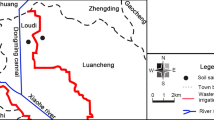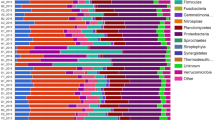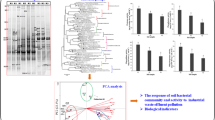Abstract
The safe utilization and risk assessment of produced water (PW) from oil and gas fields for desert irrigation have received increasing attention in recent years. In this context, this study aimed to analyze structural changes in soil bacterial community, and assess the environmental impact of PW discharge and irrigation over time. High-throughput sequencing technology was employed to examine the structure of the soil bacterial community in the constructed wetland and its surrounding desert vegetation irrigation region where PW was released for a considerable amount of time (30 years). The results revealed that long-term discharge of PW and irrigation significantly reduced the abundance of the soil bacterial community but did not significantly alter the richness and diversity of the soil bacterial community. Proteobacteria was the dominant bacterial phyla in soil, but in irrigated and drained areas, the dominant bacterial phyla changed from Alphaproteobacteria to Gammaproteobacteria, the Firmicutes abundance was significantly reduced.







Similar content being viewed by others
References
Abena MTB, Chen GQ, Chen ZY et al (2020) Microbial diversity changes and enrichment of potential petroleum hydrocarbon degraders in crude oil-, diesel-, and gasoline-contaminated soil. 3 Biotech 10(2):1–15
Acosta-González A, Martirani-von Abercron SM, Rosselló-Móra R et al (2015) The effect of oil spills on the bacterial diversity and catabolic function in coastal sediments: a case study on the Prestige oil spill. Environ Sci Pollut Res 22(20):15200–15214
Bao SD (2000) Agrochemical analysis of soil. China Agriculture Press, Beijing
Baran S, Bielinska JE, Oleszczuk P (2004) Enzymatic activity in an airfifield soil polluted with polycyclic aromatic hydrocarbons. Geoderma 118:221–232
Chen WP, Lu SD, Jiao WT et al (2013) Reclaimed water: a safe irrigation water source? Environ Dev 8:74–83
Dang QL, Tan WB, Zhao XY (2019) Linking the response of soil microbial community structure in soils to long-term wastewater irrigation and soil depth. Sci Total Environ 688:26–36
Dos Santos HF, Cury JC, Do carmo FL et al (2011) Mangrove bacterial diversity and the impact of oil contamination revealed by pyrosequencing: bacterial proxies for oil pollution. PLoS ONE 6(3):1–15
Echchelh A, Hess T, Sakrabani R (2018) Reusing oil and gas produced water for irrigation of food crops in drylands. Agric Water Manage 206:124–134
Echchelh A, Hess T, Sakrabani R et al (2019) Assessing the environmental sustainability of irrigation with oil and gas produced water in drylands. Agric Water Manage 223:105694
Edgar RC (2013) UPARSE: highly accurate OTU sequences from microbial amplicon reads. Nat Methods 10(10):996–998
Ehrenfeld JG (2004) Implications of invasive species for belowground community and nutrient. Weed Technol 18:1232–1235
EIA (2018) United States Energy Information Administration (EIA) [WWW Document]. URL
Fakhru’l-Razi A, Pendashteh A, Abdullah LC et al (2009) Review of technologies for oil and gas produced water treatment. J Hazard Mater 170:530–551
FAO, ITPS, GSBI et al et al (2020) State of Knowledge of Soil Biodiversity-Status, Challenges and Potentialities, Report 2020
Feng S, Fu Q (2013) Expansion of global drylands under a warming climate. Atmos Chem Phys 13:10081–10094
Hannah M, Kandis D, Hannah H et al (2020) Reusing oil and gas produced water for agricultural irrigation: Effects on soil health and the soil microbiome. Sci Total Environ 722:137888
He XY, Wang KL, Zhang W et al (2008) Positive correlation between soil bacterial metabolic and plant species diversity and bacterial and fungal diversity in a vegetation succession on Karst. Plant Soil 307:123–134
Kostka JE, Prakash O, Overholt WA et al (2011) Hydrocarbon-degrading bacteria and the bacterial community response in gulf of Mexico beach sands impacted by the Deepwater Horizon oil spill. Appl Environ Microbiol 77:7962–7974
Lamontagne MG, Leifer I, Bergmann S et al (2004) Bacterial diversity in marine hydrocarbon seep sediments. Environ Microbiol 6:799–808
Igunnu ET, Chen GZ (2014) Produced water treatment technologies. Int J LowCarbon Technol 9:157–177
Li H, Zhang Y, Zhang CG et al (2005) Effect of petroleum-containing wastewater irrigation on bacterial diversities and enzymatic activities in a paddy soil irrigation area. J Environ Qual 34:1073–1080
Lv H, Lin X, Su X et al (2016) C-14 Isotopes and microbial community structures as evidence for biodegradation in a petroleum hydrocarbon-contaminated aquifer. Environ Earth Sci 75(2):1–8
Madeline S, Vince P, Richard G et al (2022) Floating treatment wetlands for the bioremediation of oil spills: a review. J Environ Manage 317:115416
Marcin D, Eilen AV, Svein VA et al (2020) Colloid chemistry and experimental techniques for understanding fundamental behaviour of produced water in oil and gas production. Adv Colloid Interface Sci 276:102105
Nie M, Zhang XD, Wang JQ et al (2009) Rhizosphere effects on soil bacterial abundance and diversity in the Yellow River deltaic ecosystem as inflfluenced by petroleum contamination and soil salinization. Soil Biol Biochem 41:2535–2542
Pereira E, Silva MC, Semenov AV et al (2013) Microbe-mediated processes as in dicators to establish the normal operating range of soil func tioning. Soil Biol Biochem 57:995–1002
Phillips LA, Schefe CR, Fridman M et al (2015) Organic nitrogen cycling microbial communities are abundant in a dry Austra lian agricultural soil. Soil Biol Biochem 86:201–211
Raeid MMA, Marwan AF, Jamal AS et al (2021) Impacts of partially hydrolyzed polyacrylamide (HPAM) on microbial mats from a constructed wetland treating oilfield produced water. Chemosphere 285:131421
Ribeiro H, Mucha AP, Almeida CM et al (2013) Bacterial community response to petroleum contamination and nutrient addition in sediments from a temperate salt marsh. Sci Total Environ 458:568–576
Safriel U, Adeel Z, Niemeijer D et al (2006) Dryland systems. In: El-Kassas M, Ezcurra E (eds) Ecosystems and Human Well-Being: current state and Trends, vol 1. Island Press, Washington DC, pp 625–656
Saul DJ, Aislabie JM, Brown CE et al (2005) Hydrocarbon contamination changes the bacterial diversity of soil from around Scott Base, Antarctica. FEMS Microbiol Ecol 53:141–155
Total (2015) The life cycle of Oil and Gas Fields [WWW Document]. URL
Wang K, Yin XB, Mao HL (2018) Changes in structure and function of fungal community in cow manure composting. Bioresour Technol 255:123–130
Wang M, Sha CY, Wu J et al (2021) Bacterial community response to petroleum contamination in brackish tidal marsh sediments in the Yangtze River Estuary, China. J Environ Sci 99:160–167
Wardle DA, Bardgett RD, Klironomos JN et al (2004) Ecological linkages between aboveground and belowground biota. Science 304:1629–1633
Westover KM, Kennedy AC, Kelley SE (1997) Patterns of rhizosphere microbial community structure associated with co-occurring plant species. J Ecol 85:863–873
Xu Z, Yu G, Zhang X et al (2014) The variations in soil microbial communities, enzyme activities and their relationships with soil organic matter decomposition along the northern slope of Changbai Mountain. Appl Soil Ecol 86:19–29
Zahran HH (1997) Diversity, adaptation and activity of the bacterial flflora in saline environments. Biol Fertil Soils 25:211–223
Zhang M, Zhang C et al (2009) Pattern extraction of structural responses of gut microbiota to rotavirus infection via multivariate statistical analysis of clone library data. Fems Microbiol Eco 70(2):21–29
Zhao XY, Tan WB, Peng JJ (2020) Biowaste-source-dependent synthetic pathways of redox functional groups within humic acids favoring pentachlorophenol dechlorination in composting process. Environ Int 135:105380
Flannery CD, Tzahi YC, Terri SH (2018) Assessing the feasibility of using produced water for irrigation in Colorado. Science of the Total Environment 640–641:619–628
Min Wang, Chenyan Sha, Jian Wu et al (2021) Bacterial community response to petroleum contamination in brackish tidal marsh sediments in the Yangtze River Estuary, China. Journal of Environmental Sciences 99:160–167
Han PR, Yan C, Sun YX et al (2018) GIS-based Assessment of Eco-environmental Sensitivity in Peripheral Regions of Karamay Central Urban Area. Arid Zone Reseearch 35(5):1217-1222
Acknowledgements
This work was supported by the Xinjiang Uygur Autonomous Region Science and Technology Program Plan (Grant No. 2022E02026) and National Natural Science Foundation of China (Grant No. 52270160).
Author information
Authors and Affiliations
Corresponding authors
Ethics declarations
Conflict of Interest
The authors declare that they have no known competing financial interests or personal relationships that could have appeared to influence the work reported in this paper.
Additional information
Publisher’s Note
Springer Nature remains neutral with regard to jurisdictional claims in published maps and institutional affiliations.
Rights and permissions
Springer Nature or its licensor (e.g. a society or other partner) holds exclusive rights to this article under a publishing agreement with the author(s) or other rightsholder(s); author self-archiving of the accepted manuscript version of this article is solely governed by the terms of such publishing agreement and applicable law.
About this article
Cite this article
Wang, L., Zhu, X., Jia, H. et al. The Effects of Oil and Gas Produced Water on Soil Bacterial Community Structure in the Arid Desert Area. Bull Environ Contam Toxicol 110, 68 (2023). https://doi.org/10.1007/s00128-023-03695-8
Received:
Accepted:
Published:
DOI: https://doi.org/10.1007/s00128-023-03695-8




